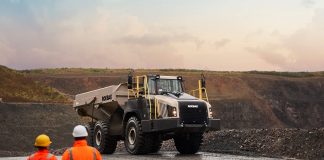The notion of assembling a fleet of robots capable of busting through concrete may be alarming to some.
However, when applied to demolition, the robots actually improve safety by removing the operator from the potentially dangerous working zone.
The Mississauga, Ontario-based Creighton Rock Drill is building a fleet of Husqvarna DXR remote demolition robots to add a new element of safety to demolition sites in Canada. The remote-controlled robots are available for rent or purchase anywhere in Eastern Canada.
“Remote controlled demolition robots are becoming more important in today’s safety-first work environment, but the barrier to ownership is in seeing the applications for them without the experience of having them available for use,” said Al Creighton, vice president of Creighton Rock Drill.
“As with any new technologies it is simple for customer to rent in order to see how this new technology fits in their applications. Creighton Rock Drill is building a rental fleet of demolition robots to give customers the opportunity to have them available without the significant investment needed to own.
“This will get them over that hump until the day they decide that they need a robot available in their fleet at all times.”
Husqvarna entered the demolition robot market in 2009, following demand from its customer base.
“We saw this as an opportunity since the industry is trending towards less manual work, focusing on improvements in efficiency and safety,” said Shawn McNeil, DXR demolition manager for Husqvarna Construction Products. “There is a clear trend in the market that operators prefer machines hammering instead of handheld hammering.”
The demolition robots may be used in various working environments. The main benefit of a robot versus heavier equipment, such as an excavator, is when the work is performed indoors.
RELATED: Shear Power Corp helps demolition companies reach new heights
The operator is able to stand away from the working zone, when there are load restrictions on the floor, and when the work area is in a confined space.
“It is also suited for work in hot environments or when hazard impact can come into consideration from the environment, for example melted steel in a steel mill,” McNeil said.
Husqvarna currently offers five demolition robot models ranging in weight from 967 kg to 2,020 kg and 20 to 30 horsepower.
The 30 hp DXR 300 is the company’s most powerful remote-controlled demolition robot. Together with the SB 302 hammer, it has the highest power-to weight ratio in its class on the market. At 78 cm wide, it fits through all normal doorways.
On the smaller end of the lineup, the DXR 140 is the Husqvarna’s most compact robot. Its arm is able to rotate 360 degrees, allowing more reach to enable the operator to work more efficiently without moving the robot.
“Working with a machine, you can reach a much higher working efficiency and you can work in all angles of the room from one spot — the wall and roof just as easily as the floor,” McNeil said.













